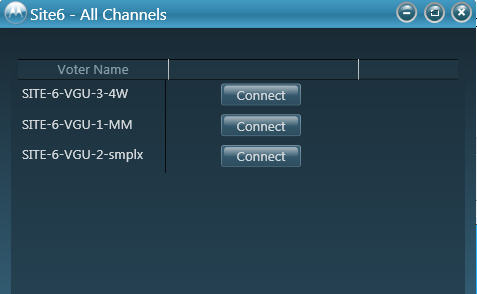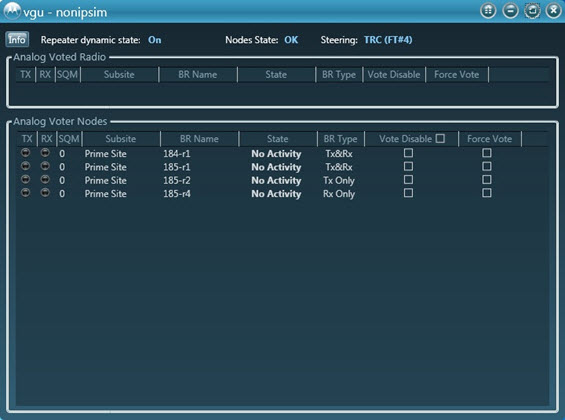Opening the Analog Display and Control Application without MLC 8000 Analog Comparator Selected
Prerequisites:
The MLC 8000 Configuration Tool is operational. See procedure Opening the MLC 8000 Configuration Tool.
When and where to use:
Use this procedure when you want to see an MLC 8000 Analog Comparator (VGU) or several MLC 8000 Analog Comparators, and not necessarily the one you are currently configuring in the configuration tool.Procedure:
- Click MLC 8000 Analog Display and Control Application in the upper left-hand corner of the MLC 8000 Configuration Tool main screen.
The Select Channel Cluster dialog box appears.
MLC 8000 Configuration Tool Select Channel Cluster Dialog Box 
- Select the correct channel cluster and then click Connect.
A dialog box showing available MLC 8000 Analog Comparators to monitor for the channel cluster selected appears.
- Select the correct MLC 8000 Analog Comparator to monitor.
The MLC 8000 Analog Display and Control Application window opens.
MLC 8000 Analog Display and Control Application Window 
- Repeater dynamic state: On or Off (the dynamic repeat state of the Voter is set by the console).
- Nodes state: OK or failed
- Steering: Details if steering type is Voted or TRC and the node/function tone by which steering was determined.
Press the Info button for additional information about the MLC 8000 Analog Comparator (VGU) such as:
- Voice Repeater Operation Status: Enabled or Disabled
- Priority: Repeat over Console or Console over repeat
- Console Type: TRC or E&M
- Digital Channel Number associated with this channel (only if this is a mixed mode channel)
- Voting Method: Continuous voting, Vote and Hold, or Regional Voting
- Voter Type: Analog Only, Mixed Mode, or Analog IP Simulcast
- Transmitter Steering: Enabled or Disabled
The left-hand column is the analog voter node LED display. The following are the color display variations along with an explanation on the meaning of each.
Tx LED is red: The radio is transmitting.
Rx LED is green: The radio is receiving.
- Gray: The radio is idle (neither transmitting or receiving).
- Tx LED is red and Rx LED is green: The radio is transmitting and receiving.
The Subsite column displays the subsite name. The BR Name column displays the base radio name. The State column provides the state of the link to the base radio. The State column can display the following states:
- Active: The base radio is active and operational.
- No Activity: The base radio is operational but there is no current activity.
Failed: The MLC 8000 Subsite Link Converter (AGU) has determined that the base radio has failed. If you move your cursor over “Failed”, a tool tip displays indicating the failure reason.
- Disabled: The base radio is disabled and thus incoming streams from this base radio are not used for voting by the MLC 8000 Analog Comparator (VGU).
The SQM column displays the signal strength the base radio measures. If there is no signal being measured for the radio, the column displays N/A. When a particular base radio is force voted, the other base radios continue to be displayed with their real SQM values unless the voting method is vote and hold, in which case the SQM values display as 0 for the other base radio. When a particular base radio is displayed with an SQM of zero, it means that either this base radio is not receiving the current RF transmission, or it is receiving the current RF transmission but it has a synchronization problem with the MLC 8000 Analog Comparator (VGU), meaning their clocks are not synchronized while the voting method is set to continuous voting.
The BR Type column displays the type of base radio which can be Rx, Tx, or Rx and Tx.
The Vote Disable column is used to disable the vote for the analog base radio. The box should be checked in this column for each base radio for which voting should be disabled. When this box is checked, incoming streams from the base radio are not used for voting by the MLC 8000 Analog Comparator.
NoteIf several base radios have been disabled for voting, they can be enabled all at once by checking the box to the right of the Disable Vote column title.The Force Vote column is used to specify whether the analog base radio should be the radio selected. Only one base radio can be selected as the force vote. When a particular radio is being force voted, voting is not used and the radio is the radio that is used.
The Voted Radio section contains information about the voted base radio. There is not always an obvious correlation between the SQM values shown in the list of base radios and the voted base radio. This situation occurs because the voting algorithm considers many factors, not all of which are obvious. For example, if a particular base radio has been restarted, it takes a few seconds to synchronize this base radio with the voter. Until this synchronization is achieved, the base radio is not voted regardless of its SQM value. If the base radio is restarted while a call is being processed, the MLC 8000 Analog Comparator (VGU) is not able to synchronize with the base radio until after the call ends. As a result, this base radio cannot become the voted radio for a longer period.
NoteIf you perform configuration changes to an MLC 8000 Analog Comparator (VGU) monitored by the Analog Display and Control application, such as changing the list of base radios associated it, an operation of force vote or disable vote is reset. This reset condition occurs whether the operation was set on the PC used to configure the channel cluster or a satellite PC. Reissue the disable vote or force vote operation using the Analog Display and Control application using the Vote Disable or Force Vote check box.